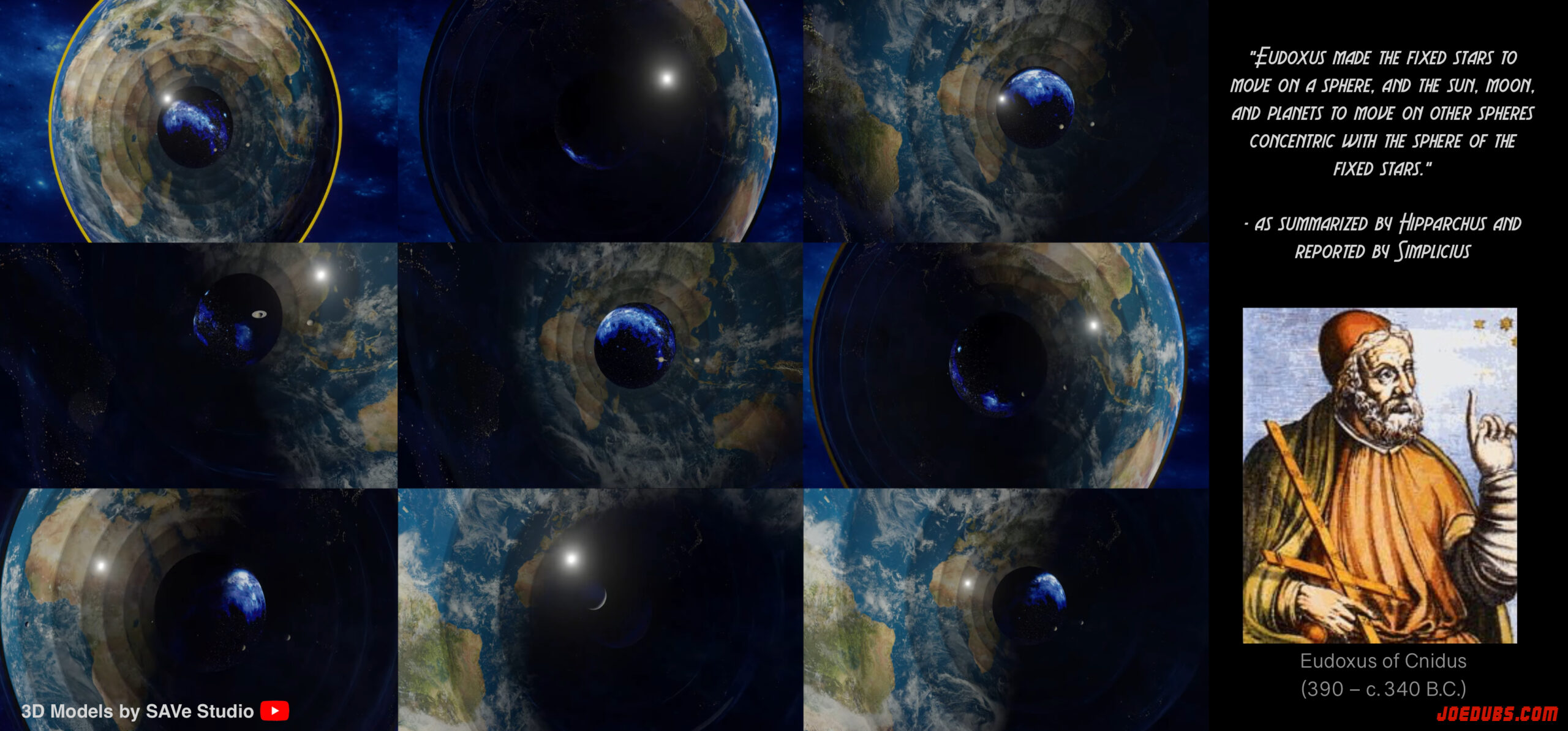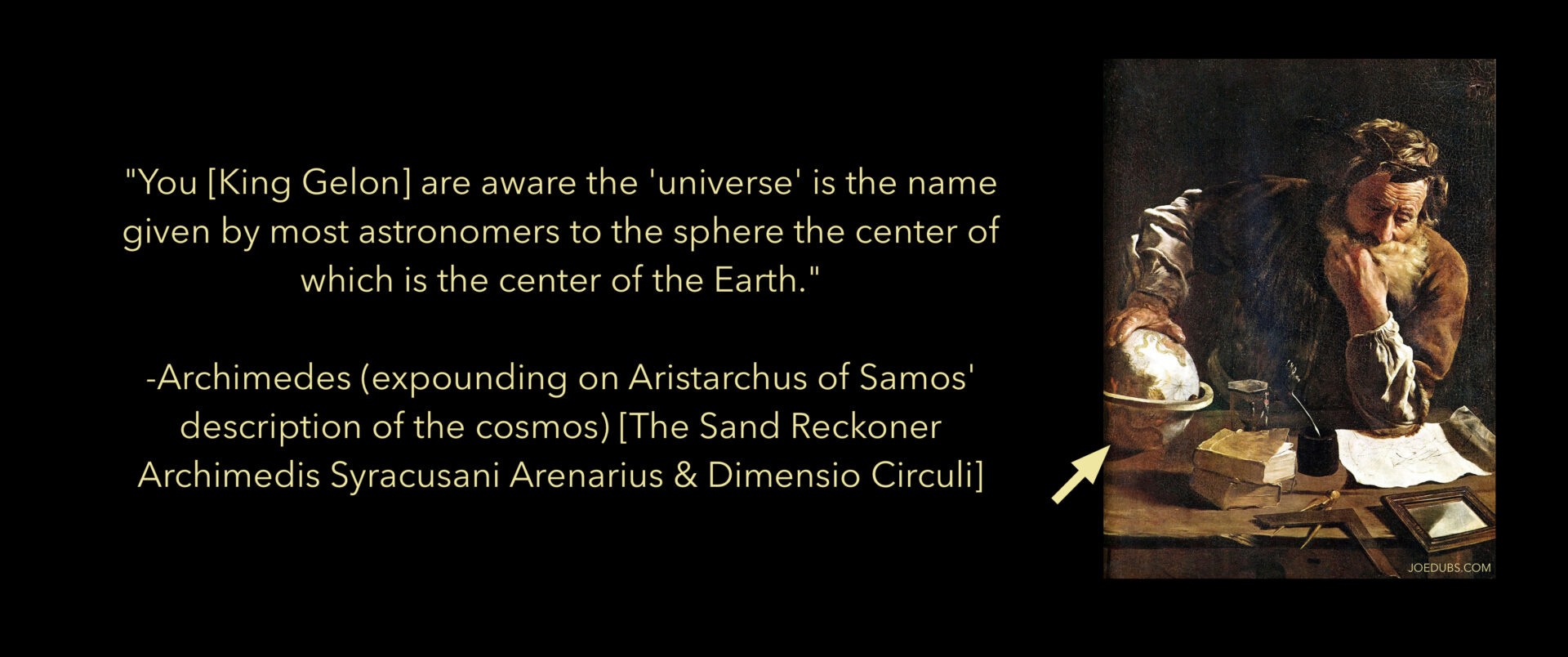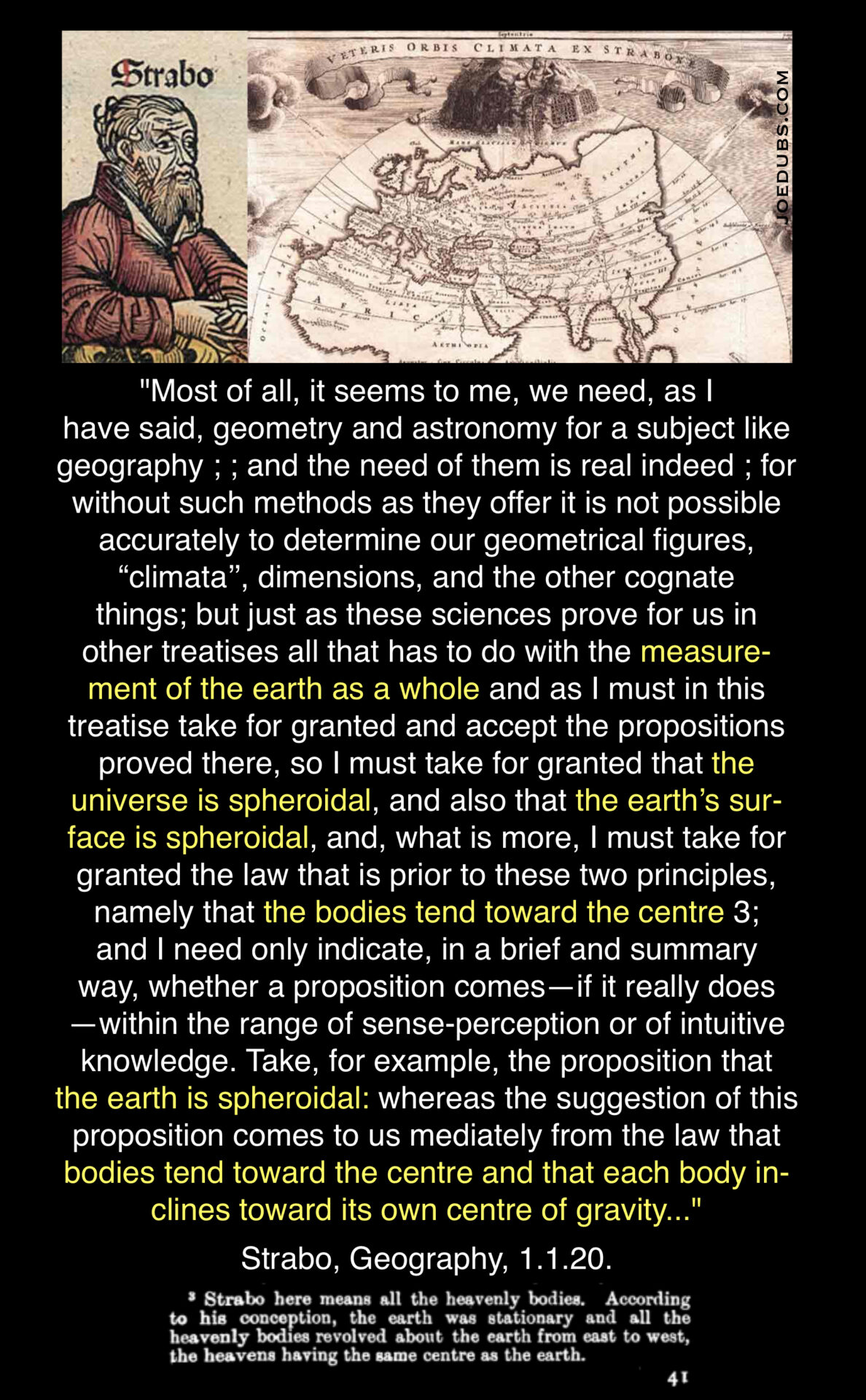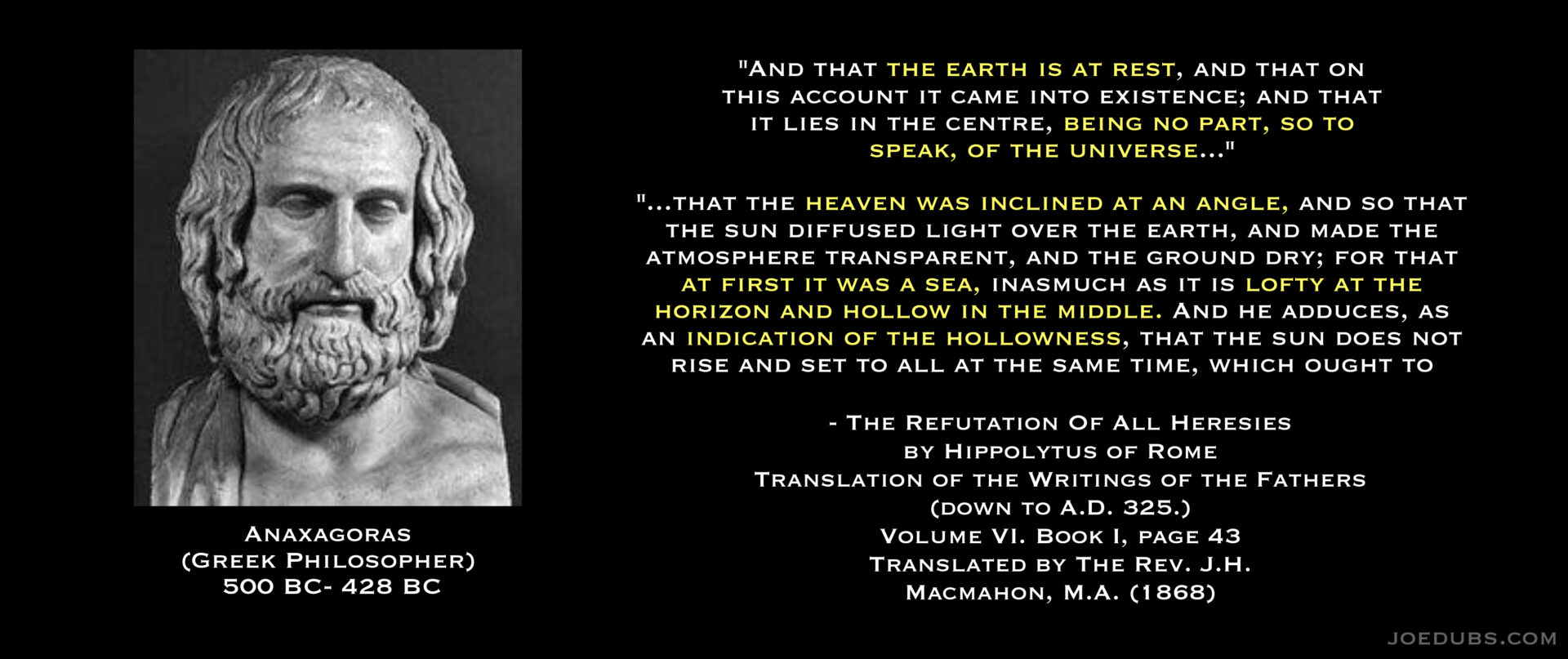The ancient Greeks understood that the only way that the complicated circuits of heaven can work is if it’s in the form of a sphere. It also begs the question, how could they conclude as to what shape the heavens are if they can’t see the border of it?
Parmenides (circa 515–450 BCE)
Parmenides was an early pre-Socratic philosopher who contributed to the idea of a spherical cosmos.
Fragment 1 of Parmenides (as quoted by Simplicius):
“The solid heavens, being circular, surround all things within them.”
Eudoxus of Cnidus (circa 390–337 BCE)
Eudoxus was an influential Greek astronomer and mathematician who developed early models of the spherical cosmos.
Eudoxus (as summarized by Hipparchus and reported by Simplicius):
“Eudoxus made the fixed stars to move on a sphere, and the sun, moon, and planets to move on other spheres concentric with the sphere of the fixed stars.”
Archimedes (circa 287–212 BCE)
Archimedes, known for his mathematical works, also discussed the spherical nature of the heavens.
Archimedes, “On the Sphere and Cylinder”:
“The surface of any sphere is equal to four times the greatest circle in it.”
Claudius Ptolemy (circa 100–170 CE)
Ptolemy’s works synthesized much of the earlier Greek astronomical knowledge, affirming the spherical nature of the heavens.
Ptolemy, “Almagest,” Book I, Chapter 3:
“The heavens are spherical in shape and move as a sphere.”
Ptolemy, “Tetrabiblos,” Book I, Chapter 2:
“For it is clear that the heavens are spherical, since they move with one and the same motion round the center, and from every part exhibit the same appearance, and because all the constellations and stars have the same relations to each other throughout the whole of each of their rotations.”
The Stoics (Zeno of Citium and others)
The Stoic philosophers also contributed to the idea of a spherical cosmos.
Diogenes Laertius, “Lives and Opinions of Eminent Philosophers,” Book VII, Zeno:
“They (the Stoics) assert that the universe is one and finite, and that the heavens are spherical and revolve.”
Cicero (106–43 BCE)
While not a Greek, Cicero’s works reflect the influence of Greek thought on Roman philosophy.
Cicero, “On the Nature of the Gods,” Book II, Section 36:
“For the world itself is a globe, the center of which is equidistant from all its parts; this is most evidently so in the heavens.”
These quotes illustrate how ancient Greek and Hellenistic philosophers, astronomers, and mathematicians contributed to and refined the concept of a spherical cosmos, influencing later scientific and philosophical thought.
Aristotle, “On the Heavens,” Book II, Part 14:
“The shape of the heaven is of necessity spherical; for that is the shape most appropriate to its substance and also by nature primary.”
Aristotle, “On the Heavens,” Book II, Part 14:
“Again, our observations of the stars make it evident, not only that the earth is circular, but also that it is a circle of no great size.”
Theophrastus (circa 371–287 BCE)
A student of Aristotle, Theophrastus continued the tradition of describing the heavens as spherical.
Theophrastus, “On the Heavens” (fragments):
“The universe is spherical, and so are all the stars and planets.”
Lucretius (circa 99–55 BCE)
A Roman poet and philosopher, Lucretius wrote about the spherical nature of the heavens in his epic poem.
Lucretius, “De Rerum Natura” (On the Nature of Things), Book V, lines 449-453:
“The clear light of heaven and the sun’s heat, then, must be kept together in spherical shapes, enclosed within the bonds of air.”
Geminus of Rhodes (circa 110–40 BCE)
Geminus was a Greek astronomer who wrote about the spherical nature of the heavens in his works.
Geminus, “Introduction to the Phenomena,” Chapter 1:
“The heaven is spherical in form, and it moves as a sphere.”
Strabo (circa 64 BCE–24 CE)
Strabo, a Greek geographer, also referenced the spherical nature of the heavens.
Strabo, “Geography,” Book II, Chapter 5:
“And let no one imagine that the heavens are like a canopy or a tent; rather, the heavens are spherical, being made up of the two hemispheres of the celestial sphere.”
Seneca (circa 4 BCE–65 CE)
A Roman philosopher influenced by Stoic and Greek thought, Seneca discussed the spherical nature of the heavens in his naturalistic writings.
Seneca, “Natural Questions,” Book VII, Chapter 2:
“The shape of the heaven is spherical, and it moves in a sphere around the earth.”
Cleomedes (circa 2nd century CE)
Cleomedes wrote a comprehensive treatise on astronomy, supporting the spherical nature of the heavens.
Cleomedes, “On the Circular Motions of the Celestial Bodies,” Book I, Chapter 2:
“The heaven is spherical in shape and revolves continuously around the earth.”
Additional Quotes:
1. Leucippus (circa 5th century BCE)
Leucippus, the founder of the atomic theory, had cosmological views that included the idea of a spherical universe.
Leucippus (as reported by Aetius, Placita, I.3.6): “Leucippus says that the cosmos is spherical in form, and that it arises from the vortex motion of atoms.”
2. Xenophanes (circa 570–478 BCE)
Xenophanes challenged traditional religious views but also contributed to cosmological discussions.
Xenophanes (as reported by Aetius, Placita, II.2.6): “The upper limit of the heavens is spherical, and the earth stretches infinitely beneath it.”
3. Anaxagoras (circa 500–428 BCE)
– Anaxagoras introduced the concept of Nous (Mind) as a cosmic force and had a distinctive cosmology.
– Anaxagoras (as summarized by Simplicius in Commentary on Aristotle’s Physics): “The earth is flat, but the heavenly bodies, being spherical, revolve around it.”
4. Empedocles (circa 494–434 BCE)
– Empedocles, known for his theory of the four classical elements, also had views on the cosmos.
– Empedocles (as quoted by Simplicius, Commentary on Aristotle’s Physics): “The heavens are spherical and move in a perfect circle, enclosing the earth at the center.”
5. Epicurus (circa 341–270 BCE)
– While Epicurus is often associated with atomism, his cosmological views included the concept of spherical heavens.
– Epicurus (as reported by Diogenes Laertius, Lives of Eminent Philosophers, X.73): “The world is spherical, and the heavens, also spherical, revolve around it.”
6. Hipparchus (circa 190–120 BCE)
– Hipparchus, a prominent astronomer, made significant contributions to the understanding of celestial spheres.
– Hipparchus (as summarized by Ptolemy in Almagest): “The heavens are spherical, and the stars are fixed upon a rotating celestial sphere.”
7. Poseidonius (circa 135–51 BCE)
– Poseidonius, a Stoic philosopher and polymath, contributed to the understanding of the spherical cosmos.
– Poseidonius (as reported by Strabo, Geography, II.2.2): “The earth and the heavens are spherical, and the heavens revolve around the earth in circular motion.”
8. Crates of Mallus (circa 2nd century BCE)
– Crates, a grammarian and philosopher, promoted the idea of a spherical earth and heavens.
– Crates of Mallus (as summarized by Strabo, Geography, I.4.9): “Crates says that the heavens are spherical and revolve around the earth, which is also spherical.”
Additional Quotes:
1. Philoponus (circa 490–570 CE)
– John Philoponus, a later commentator on Aristotle, defended the spherical shape of the cosmos against competing views.
– Philoponus, Commentary on Aristotle’s Physics “The spherical shape of the heavens is clear, as they encircle the earth and are the most suitable form for their motion.”
2. Hippolytus of Rome (circa 170–235 CE)
– Hippolytus, an early Christian theologian, also engaged with Greek cosmology in his writings.
– Hippolytus, Refutation of All Heresies, Book I, Chapter 6: “The heavens are spherical in shape, and they revolve in a circular motion around the earth.”
“The Earth, too, is situated in the middle of the universe, spherical in shape, and remains in the same place because of its equal distance from all parts of the universe.”
-Cleomedes, On the Heavens, Book I, Chapter 5
3. Basil of Caesarea (circa 329–379 CE)
– Though primarily a theologian, Basil of Caesarea discussed cosmology in his works, influenced by Greek thought.
– Basil, Hexaemeron (Homily 1): “The structure of the heavens is spherical, as is befitting the natural motion of the celestial bodies.”
4. Eratosthenes (circa 276–194 BCE)
– Eratosthenes, known for calculating the circumference of the Earth, also supported the spherical nature of the heavens.
– Eratosthenes (as reported by Cleomedes in On the Circular Motions of the Celestial Bodies): “The heavens are spherical, and the stars move in concentric spheres around the earth.”
5. Chrysippus (circa 279–206 BCE)
– A major Stoic philosopher, Chrysippus supported the Stoic view of a spherical cosmos.
– Chrysippus (as quoted by Diogenes Laertius, Lives and Opinions of Eminent Philosophers, VII.142): “The heavens are spherical in form, encompassing the earth, which lies in the center.”
6. Aristarchus of Samos (circa 310–230 BCE)
– Although known for proposing a heliocentric model, Aristarchus also accepted the spherical nature of the heavens.
– Aristarchus (as reported by Archimedes in The Sand Reckoner): “Aristarchus posits that the heavens are spherical, and they rotate around a fixed center.”
7. Seleucus of Seleucia (circa 190–150 BCE)
– A follower of Aristarchus, Seleucus supported both the heliocentric model and the idea of a spherical universe.
– Seleucus (as summarized by Plutarch in Platonic Questions): “Seleucus argued for the spherical nature of the heavens, which move in harmony around the spherical earth.”
8. Hipparchus (circa 190–120 BCE)
– Known for his work in astronomy, Hipparchus contributed to the idea of spherical heavens in his star catalogs.
– Hipparchus (as reported by Strabo in Geography, Book II): “The spherical shape of the heavens is evident from the motion of the stars and the fixed constellations.”
These additional figures and quotes further expand on the widespread belief in a spherical cosmos in ancient Greek and Hellenistic thought, continuing to emphasize the influence of this concept throughout various fields and periods.
EARTH DOES NOT MOVE!!!
Seneca (4 B.C. to 65 A.D.)
Here are additional relevant excerpts from Seneca’s “Naturales Quaestiones” that discuss the nature and position of the Earth:
On the stationary Earth:
– “The Earth does not move; it is fixed in the center of the universe, and all the celestial bodies revolve around it.” (Naturales Quaestiones, Book VII, Chapter 19)
On the Earth’s position in the cosmos:
– “The universe surrounds the Earth in the middle, as the center point. Everything that is born, that moves, and that ceases to be, is contained within this encompassing structure.” (Naturales Quaestiones, Book III, Chapter 29)
During the time of Seneca (circa 4 BCE to 65 CE), the geocentric model of the universe, which posited a stationary Earth at the center of the cosmos, was widely accepted. This model was strongly supported by earlier Greek philosophers and continued to be the dominant view during the Roman Empire. Here are some relevant quotes from thinkers around that period that support the idea of a stationary Earth:
Quotes Supporting a Stationary Earth (circa 1st century BCE to 1st century CE):
1. Cicero (106–43 BCE)
– Cicero, On the Nature of the Gods, Book II, Section 105:
– “The Earth remains fixed and unmoved in the center of the universe; all other bodies revolve around it.”
2. Pliny the Elder (23–79 CE)
– Pliny the Elder, Natural History, Book II, Chapter 4:
– “It is clear that the Earth, which alone is fixed and immovable, occupies the central position in the universe, and that all things move towards it.”
3. Vitruvius (circa 80–15 BCE)
– Vitruvius, De Architectura, Book IX, Chapter 1:
– “The Earth, placed in the center of the universe, remains at rest, while the heavens turn around it in eternal motion.”
THE REFUTATION OF ALL HERESIES, BY HIPPOLYTUS
TRANSLATED BY THE EEY. J. H. MACMAHON, M.A
https://archive.org/stream/refutationofallh01hipp/refutationofallh01hipp_djvu.txt
4. Ptolemy (circa 100–170 CE)
– Ptolemy, Almagest, Book I, Chapter 7:
– “The Earth occupies the central place in the universe and remains stationary, while the heavens move in a circular motion around it.”
5. Seneca (circa 4 BCE–65 CE)
– Seneca, Natural Questions, Book VII, Chapter 2:
– “The Earth, at the center of the cosmos, does not move, while the heavens, in their spherical form, revolve around it.”
6. Strabo (circa 64 BCE–24 CE)
– Strabo, Geography, Book I, Chapter 1:
– “The Earth is at rest in the center of the universe, and the heavens, with their stars and planets, revolve around it.”
7. Plutarch (circa 46–119 CE)
– Plutarch, On the Apparent Face in the Orb of the Moon
– “The Earth, being stationary, is encircled by the heavens, which move with regularity, carrying with them the stars and planets.”
8. Lucan (39–65 CE)
– Lucan, Pharsalia, Book IX, Line 528:
– “The Earth stands firm in the center, while the heavens circle around it, never altering their eternal course.”
9. Posidonius (circa 135–51 BCE)
– Posidonius (as reported by Cleomedes, On the Circular Motions of the Celestial Bodies):
– “The Earth remains fixed in place, while the heavens revolve in a circular motion around it.”
Discover more from JoeDubs
Subscribe to get the latest posts sent to your email.






Try to like your brilliant article and spherical Greek conception. However, what do me to log into WordPress so I did and then it gave me a request access. I don\’t know if that was for your personal site or or access to your site for commentary and likes. So if it\’s requesting access for your personal site, it\’s an accident. It\’s a little confusing.
Sent from Proton Mail Android
Thanks Seth, appreciate it!